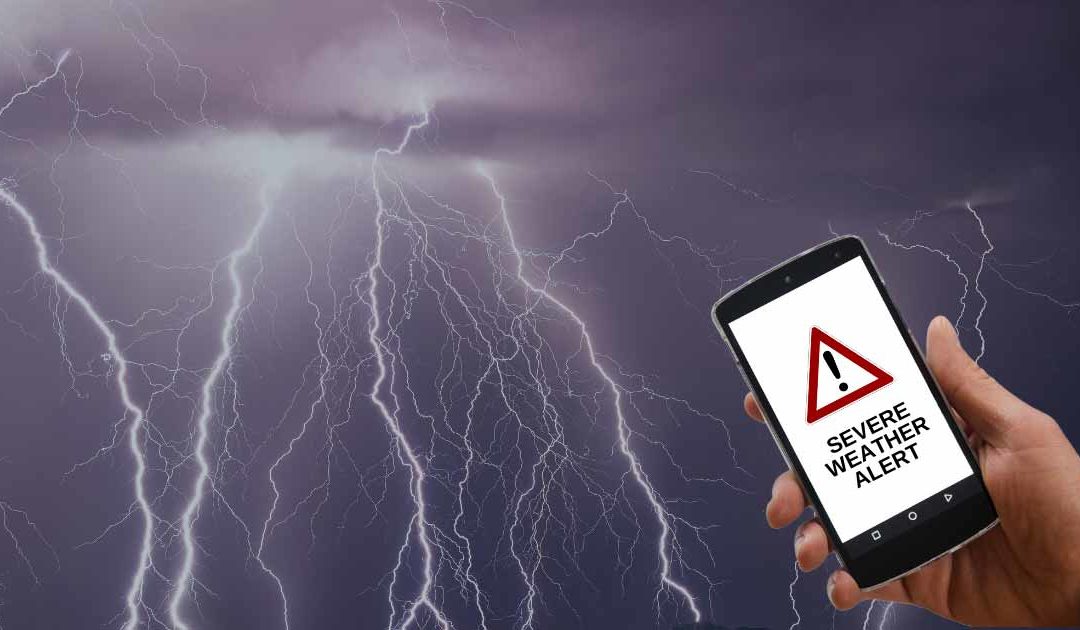Many things in life come without warnings. But fortunately for us, severe weather isn’t one of them.
Meteorologists are constantly tracking dangerous storms and weather patterns. Tapping into their early warnings is key to protecting your home, your possessions, and your family. Here’s what you need to know to stay one step ahead of Mother Nature.
First, let’s take a look at severe weather.
There are many types of severe weather. Examples include thunderstorms, snowstorms, hail storms, blizzards, hurricanes, tornados, and cyclones. High winds and flooding associated with some of these weather events can do great damage to your home and belongings. Having a disaster plan is great, but knowing when disaster is going to strike is crucial. That’s where early warning systems come in.
Chances are you already have an emergency alert system.
The U.S. government has the capability to send wireless emergency alerts (WEAs) right to our cell phones. Agencies like the National Weather Service and FEMA are among the organizations that can do so. There is no signup required and you are not charged for the data used. Alerts come automatically with a special sound and vibration. Most phones are enabled for these alerts; to find out if your particular model is, check the WEA enabled list or contact your wireless carrier.
Check to see that your phone is enabled for alerts.
WEAs may be free but if your phone isn’t enabled to receive them, you won’t. Fortunately, it’s easy to activate this setting.
Apple (IOS) phones
-
- Go to settings, then notifications.
- Scroll down to government alerts.
- Slide the circle so that it is green for the alerts you want. For severe weather, you will want emergency alerts and public safety alerts.
Android phones
-
- Go to apps & notifications.
- Click on notifications.
- Turn on “allow alerts.”
- Make sure each alert that you want is enabled. For severe weather, you will want extreme threats, severe threats, public safety messages, and state and local tests.
While WEAs are good ways to get information, generally these alerts won’t arrive until there is an emergency. You may find value in getting advance notice.
Other ways to get emergency information:
If you do not have a WEA-capable phone, you can still get critical and timely information from NOAA Weather Radio, local media broadcasts, and the emergency alert system on your TV or desktop and mobile devices. Make sure to tune in if you suspect an impending weather emergency. In addition, your local utility company, township, city or state may offer free alerts. Check with your electric or gas company, and with city hall or municipal government. Find out how to sign up for their free alerts.
There’s an app for that, and it’s free.
You can get advance notice and more robust information by downloading a weather app on your smartphone or mobile device. Here are some popular free options.
-
- AccuWeather: Weather Alerts provides hourly forecasts, news, and updates as well as weather-tracking radar.
- AlertSense offers public safety alerts as well as severe weather warnings. You can set quiet hours so only emergency alerts are sent with sound.
- Emergency: Alerts is free from the American Red Cross. With this app, you can look up Red Cross shelters and alert loved ones you are safe. It also comes with a flashlight, a strobe light, an alarm, and preloaded content on everything from hurricanes to disasters that is accessible without an Internet connection
- FEMA offers real-time weather alerts from the National Weather Service for up to five locations of your choice. It also provides information on storm preparedness and filing a flood claim.
- Storm Shield is free with options for paid upgrades. This app provides alerts in text and voice and tracks conditions in up to 5 locations.
- WeatherBug is free with options to purchase in the app. It offers forecasts in real-time as well as weather maps, and more.
- The Weather Channel for Apple or Android offers live radar updates and local weather forecasts.
Stay one step ahead of Mother Nature with coverage from California Casualty.
No matter how well you prepare for severe weather, unfortunately, sometimes Mother Nature gets the upper hand. That’s why having the correct home insurance coverage is so important. Make sure you and your family are fully protected. For questions on home insurance or ways, you can save on your own insurance policy, call a California Casualty agent today at 1.866.704.8614 or visit our website www.calcas.com.
This article is furnished by California Casualty, providing auto and home insurance to educators, law enforcement officers, firefighters, and nurses. Get a quote at 1.866.704.8614 or www.calcas.com.
- Graduation – When to Remove Your Child from Your Auto Policy - May 18, 2023
- How to Prevent Catalytic Converter Theft - May 17, 2023
- How Much Does Home Insurance Cost? - May 17, 2023


Really enjoyed this!